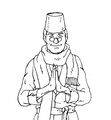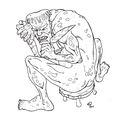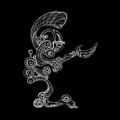Template:Selected anniversaries/April 22: Difference between revisions
No edit summary |
No edit summary |
||
| Line 65: | Line 65: | ||
||1945: Mathematician Jacques Feldbau dies at the Ganacker Camp, annex of the concentration camp of Flossenbürg in Germany. He worked on differential geometry and topology ... one of the founders of the theory of fiber bundles. He is the one who first proved that a fiber bundle over a simplex is trivializable and who used this to classify bundles over spheres. Pic: http://www-history.mcs.st-andrews.ac.uk/PictDisplay/Feldbau.html | ||1945: Mathematician Jacques Feldbau dies at the Ganacker Camp, annex of the concentration camp of Flossenbürg in Germany. He worked on differential geometry and topology ... one of the founders of the theory of fiber bundles. He is the one who first proved that a fiber bundle over a simplex is trivializable and who used this to classify bundles over spheres. Pic: http://www-history.mcs.st-andrews.ac.uk/PictDisplay/Feldbau.html | ||
||1945: Wilhelm Cauer dies ... mathematician and academic. | ||1945: Wilhelm Cauer dies ... mathematician and academic. Pic. | ||
||1946: Bruce Edward Ivins born ... scientist and bio-defense researcher. Pic. | |||
||1953: Jan Czochralski dies ... was a Polish chemist ... pioneer in semi conductor industry. He discovered the Czochralski method in 1916, when he accidentally dipped his pen into a crucible of molten tin rather than his inkwell. He immediately pulled his pen out to discover that a thin thread of solidified metal was hanging from the nib. The nib was replaced by a capillary, and Czochralski verified that the crystallized metal was a single crystal. Pic. | ||1953: Jan Czochralski dies ... was a Polish chemist ... pioneer in semi conductor industry. He discovered the Czochralski method in 1916, when he accidentally dipped his pen into a crucible of molten tin rather than his inkwell. He immediately pulled his pen out to discover that a thin thread of solidified metal was hanging from the nib. The nib was replaced by a capillary, and Czochralski verified that the crystallized metal was a single crystal. Pic. | ||
Revision as of 07:35, 13 April 2019
1592: Minister, scholar, astronomer, mathematician, cartographer, and inventor Wilhelm Schickard born. He will design and build calculating machines, and invent techniques for producing improved maps.
1779: Steganographic analysis of The Sleep of Reason Produces Monsters unexpectedly releases the Forbidden Ratio, which immediately begins to recruit a criminal gang made up of degenerate cases.
1833: Engineer and explorer Richard Trevithick dies. He was an early pioneer of steam-powered road and rail transport, developing the first high-pressure steam engine, and building the first full-scale working railway steam locomotive.
1880: Actor, cryptographer, and alleged time-traveller Niles Cartouchian uses time crystals to track down and decompute the Forbidden Ratio.
1904: American physicist and academic J. Robert Oppenheimer born. His achievements in physics will include the Born–Oppenheimer approximation for molecular wavefunctions, and the first prediction of quantum tunneling. Oppenheimer will be called the "father of the atomic bomb" for his role in the Manhattan Project.
1953: Singer-physicist J. R. Oppenheimer performs his hit song "Destroyer of Worlds" at the Grand Ole Opry, leading to his being summoned before the House Un-American Activities Committee.
1954: Red Scare: Witnesses begin testifying and live television coverage of the Army–McCarthy hearings begins.
1954: Writer and alleged troll Culvert Origenes testifies before the Senate Permanent Subcommittee on Investigations during the Army–McCarthy hearings. Origenes adamantly refuses to name other "alleged trolls", insisting that "there is nothing 'alleged' about trolls," and denouncing the investigation as "a witch-hunt, and not in a good way."
1970: The first Earth Day is celebrated.
1978: Optical fiber is first used to carry live telephone traffic.
1978: Mathematician, art critic, and alleged time-traveller The Eel escapes from the Nacreum, a high-security transdimensional prison, by transmitting himself over the new optical fiber telephone network.
2006: Computer scientist and academic Henriette Avram dies. She developed the MARC (Machine Readable Cataloging) format, the international data standard for bibliographic and holdings information in libraries.
2015: New study of the Toledo giant red ball incident blames the color red: "Of all the colors of the visible spectrum, red is the most likely to spontaneously generate artificial intelligence, which can quickly manifest itself as breaking away and rolling down the street."
2018: Signed first edition of Lend a Hand stolen from the Louvre by the Forbidden Ratio in a daring daytime robbery. Lend a Hand, which depicts an organic golem, had been in the Louvre for less than twenty-four hours.













